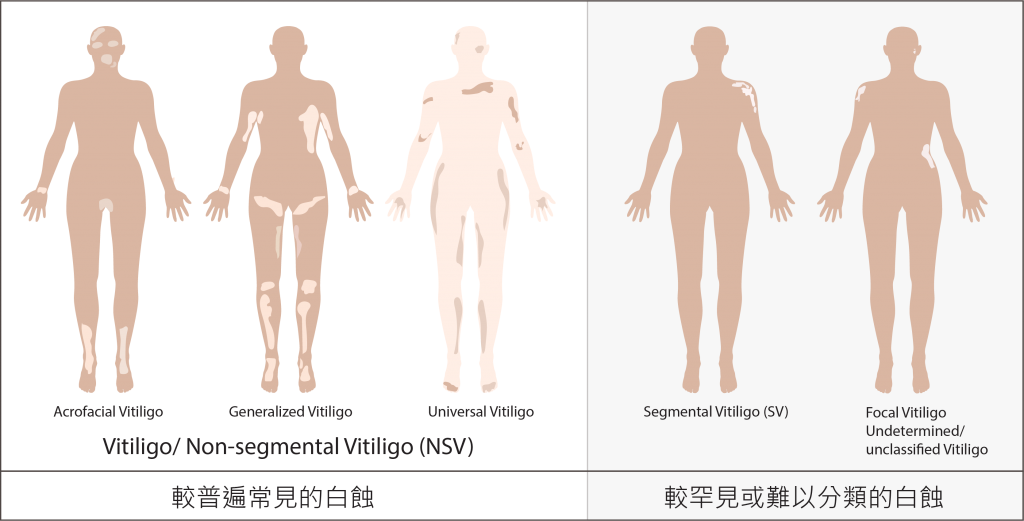What is Vitiligo?

Vitiligo affects 0.1-2% of the global population, approximately 70 million people; research has found that about 80% of vitiligo is related to genetic factors; the remaining 20% can be attributed to environmental or other factors.
Vitiligo (also known as Leukoderma) is a non-contagious autoimmune disease, meaning our own immune system mistakenly regards the melanocytes (skin pigment cells) as enemies, gradually reducing the melanin, causing white spots to appear on the skin. Most cases develop at a young age. Vitiligo often appears on the face, neck, and head; but it can also be found on the hands, around the eyes, ears, mouth, nipples, and genitals. If vitiligo appears on the head, the hair also turns white. Vitiligo is very distressing for patients because the uneven color can significantly reduce self-confidence. Additionally, some people who are unaware may mistakenly think that the disease is contagious and avoid the patients, further damaging their self-esteem.
Vitiligo (also known as Leukoderma) is a non-contagious autoimmune disease, meaning our own immune system mistakenly regards the melanocytes (skin pigment cells) as enemies, gradually reducing the melanin, causing white spots to appear on the skin. Most cases develop at a young age. Vitiligo often appears on the face, neck, and head; but it can also be found on the hands, around the eyes, ears, mouth, nipples, and genitals. If vitiligo appears on the head, the hair also turns white. Vitiligo is very distressing for patients because the uneven color can significantly reduce self-confidence. Additionally, some people who are unaware may mistakenly think that the disease is contagious and avoid the patients, further damaging their self-esteem.
In 2011, the Vitiligo Global Issues Consensus Conferencean internationally recognized organization, broadly defined vitiligo (V) as several types of Non-segmental vitiligo (NSV); whereas Segmental vitiligo (SV) was distinguished as separate from the generalized vitiligo. Differentiating between V/NSV and SV is significant because their causes, treatment methods, and expectations for the progression of the vitiligo spots are all different.

Reference:
Bergqvist C, Ezzedine K. Vitiligo: A focus on pathogenesis and its therapeutic implications. J Dermatol. 2021 Mar; 48(3):252-270.
Mohammad TF, Al-Jamal M, Hamzavi IH, et al. The Vitiligo Working Group recommendations for narrowband ultraviolet B light phototherapy treatment of vitiligo. J Am Acad Dermatol. 2017;76:879–888.
Global Vitiligo Foundation (GVF)(formerly Vitiligo Working Group) - https://globalvitiligofoundation.org/
The NHS website - https://www.nhs.uk/conditions/vitiligo/
Vitiligo Society UK - https://vitiligosociety.org/
The American Vitiligo Research Foundation, Inc.(AVRF) - https://www.avrf.org/
National Vitiligo Bond Inc Foundation - http://vitiligobond.org/
Bergqvist C, Ezzedine K. Vitiligo: A focus on pathogenesis and its therapeutic implications. J Dermatol. 2021 Mar; 48(3):252-270.
Mohammad TF, Al-Jamal M, Hamzavi IH, et al. The Vitiligo Working Group recommendations for narrowband ultraviolet B light phototherapy treatment of vitiligo. J Am Acad Dermatol. 2017;76:879–888.
Global Vitiligo Foundation (GVF)(formerly Vitiligo Working Group) - https://globalvitiligofoundation.org/
The NHS website - https://www.nhs.uk/conditions/vitiligo/
Vitiligo Society UK - https://vitiligosociety.org/
The American Vitiligo Research Foundation, Inc.(AVRF) - https://www.avrf.org/
National Vitiligo Bond Inc Foundation - http://vitiligobond.org/
